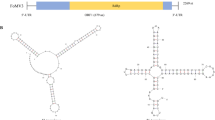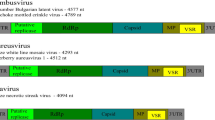Abstract
The lackey moth, Malacosoma neustria (Linnaeus, 1758), a worldwide pest, causes extensive economic losses particularly on hazelnut, plum, oak, poplar, and willow trees. A baculovirus, Malacosoma neustria nucleopolyhedrovirus (ManeNPV-T2), has been isolated from the larvae collected in Turkey and appears to have a potential as a microbial control agent. In this study, we describe the complete genome sequence of ManeNPV-T2 and compare it to other sequenced baculovirus genomes. The ManeNPV-T2 genome is a circular double-stranded DNA molecule of 130,202 bp, has 38.2% G + C, and is predicted to contain 131 putative open reading frames (ORFs) each with a coding capacity of more then 50 amino acids. There are 27 ORFs with unknown function of which 6 are unique to ManeNPV-T2. Eleven homologous regions (hrs) and two bro genes (bro-a and bro-b) were identified in the genome. There are two homologues of chaB and nicotinamide riboside kinase-1 genes, separated from themselves with a few nucleotides. Additionally, ac145, thought to be per os infectivity factor (pif) gene, is also found as two homologues. All 38 core genes are found in the ManeNPV-T2 genome. The phylogenetic tree of ManeNPV-T2 in relation to 50 other baculoviruses whose genomes have been completely sequenced showed ManeNPV-T2 to be closely related to the group II NPVs. This study expands our knowledge on baculoviruses, describes the characterization ManeNPV, and ultimately contributes to the registration of this virus as a microbial pesticide.



Similar content being viewed by others
References
Theilmann DA, Blissard GW, Bonning B, Jehle JA, O’Reilly DR, Rohrmann GF, Thiem SVJ (2005) Baculoviridae. In: Fauquet CX, Mayo MA, Maniloff J, Desselberger UBLA (eds) Virus taxonomy-classification and nomenclature of viruses. 8th Report of the international committee on the taxonomy of viruses, 8th edn. Elsevier, Amsterdam, pp 177–185
Demir I, Nalcacioglu R, Demirbag Z (2008) The significance of insect viruses in biotechnology. Tarım Bilim Derg 14(2):193–201 (in Turkish with English abstract)
Slack J, Arif BM (2007) The baculoviruses occlusion-derived virus: virion structure and function. Adv Virus Res 69:99–165. https://doi.org/10.1016/S0065-3527(06)69003-9
Ackermann HW, Smirnoff WA (1983) A morphological investigation of 23 baculoviruses. J Invertebr Pathol 41:269–280. https://doi.org/10.1016/0022-2011(83)90244-6
Jehle JA, Lange M, Wang H et al (2006) Molecular identification and phylogenetic analysis of baculoviruses from Lepidoptera. Virology 346:180–193. https://doi.org/10.1016/j.virol.2005.10.032
Rohrmann G (2011) The AcMNPV genome: gene content, conservation, and function. In: Rohrmann G (ed) Baculovirus molecular biology. National Library of Medicine (US), Bethesda
Blissard GW, Wenz JR (1992) Baculovirus gp64 envelope glycoprotein is sufficient to mediate pH-dependent membrane fusion. J Virol 66:6829–6835
Bulach DM, Kumar CA, Zaia A et al (1999) Group II nucleopolyhedrovirus subgroups revealed by phylogenetic analysis of polyhedrin and DNA polymerase gene sequences. J Invertebr Pathol 73:59–73. https://doi.org/10.1006/jipa.1998.4797
Jiang Y, Deng F, Rayner S et al (2009) Evidence of a major role of GP64 in group I alphabaculovirus evolution. Virus Res 142:85–91. https://doi.org/10.1016/j.virusres.2009.01.015
Santos ER, Oliveira LB, Peterson L et al (2018) The complete genome sequence of the first hesperiid-infecting alphabaculovirus isolated from the leguminous pest Urbanus proteus (Lepidoptera: Hesperiidae). Virus Res 249:76–84. https://doi.org/10.1016/j.virusres.2018.03.009
Harrison RL, Rowley DL, Mowery JD et al (2017) The Operophtera brumata nucleopolyhedrovirus (OpbuNPV) represents an early, divergent lineage within genus Alphabaculovirus. Viruses 9(10):307. https://doi.org/10.3390/v9100307
Ozbek H, Calmasur O (2005) A review of insects and mites associated with roses in Turkey. Acta Hortic 690:167–174. https://doi.org/10.17660/ActaHortic.2005.690.25
Ministry of Agriculture of Turkey (2008) The agricultural control technical recommendations, vol. 4. Başak Publisher. Ankara (in Turkish)
Ozbek H, Coruh S (2010) Egg parasitoids of Malacosoma neustria (Linnaeus, 1758) (Lepidoptera: Lasiocampidae) in Erzurum province of Turkey. Turk J Entomol 34:551–560
Kovaĉević Z (1926) Der Ringelspinner und der Schwammspinner und ihre Parasiten. Anzeiger für Schädlingskd 2:93–94. https://doi.org/10.1007/BF02340344
Demir I, Gürel N, Nalcacioglu R et al (2009) Productive replication of Malacosoma neustria nucleopolyhedrovirus (ManeNPV) in Md203 cell line. Turk J Biol 33:239–248. https://doi.org/10.3906/biy-0805-5
Keddie B, Erlandson M, Hilchie G (1995) Establishment and characterization of three Malacosoma disstria cell lines. J Invertebr Pathol 66:136–142. https://doi.org/10.1006/jipa.1995.1076
Demir I, Gürel N, Nalcacioglu R, Demirbag Z (2009) Comparative susceptibilities of six insect cell lines to infection by Malacosoma neustria nucleopolyhedrovirus (ManeNPV). Turk J Biol 33:259–273. https://doi.org/10.3906/biy-0808-9
Demir I, Nalcacioglu R, Mohammad Gholizad L, Demirbag Z (2013) Characterization of a new isolate of Malacosoma neustria nucleopolyhedrovirus (ManeNPV) from Turkey. Turk J Biol 37:385–391. https://doi.org/10.3906/biy-1209-24
Demir I, Nalcacioglu R, Mohammad Gholi̇zad L, Demirbag Z (2014) A highly effective nucleopolyhedrovirus against Malacosoma spp. (Lepidoptera: Lasiocampidae) from Turkey: isolation, characterization, phylogeny, and virulence. Turk J Agric For 38:462–470. https://doi.org/10.3906/tar-1307-32
Reed C, Otvos IS, Reardon R et al (2003) Effects of long-term storage on the stability of OpMNPV DNA contained in TM Biocontrol-1. J Invertebr Pathol 84:104–113. https://doi.org/10.1016/j.jip.2003.08.002
Benson G (1999) Tandem repeats finder: a program to analyze DNA sequences. Nucleic Acids Res 27:573–580. https://doi.org/10.1093/nar/27.2.573
Kraemer L, Beszteri B, Gäbler-Schwarz S et al (2009) STAMP: extensions to the STADEN sequence analysis package for high throughput interactive microsatellite marker design. BMC Bioinform 10:41. https://doi.org/10.1186/1471-2105-10-41
Solovyev VV, Salamov AA (1999) INFOGENE: a database of known gene structures and predicted genes and proteins in sequences of genome sequencing projects. Nucleic Acids Res 27:248–250. https://doi.org/10.1093/nar/27.1.248
Hu ZH, Arif BM, Jin F et al (1998) Distinct gene arrangement in the Buzura suppressaria single-nucleocapsid nucleopolyhedrovirus genome. J Gen Virol 79:2841–2851. https://doi.org/10.1099/0022-1317-79-11-2841
Katoh K, Misawa K, Kuma K, Miyata T (2002) MAFFT: a novel method for rapid multiple sequence alignment based on fast Fourier transform. Nucleic Acids Res 30:3059–3066. https://doi.org/10.1093/nar/gkf436
Kumar S, Stecher G, Tamura K (2016) MEGA7: Molecular Evolutionary Genetics Analysis Version 7.0 for Bigger Datasets. Mol Biol Evol 33:1870–1874. https://doi.org/10.1093/molbev/msw054
Vlak JM, Smith GE (1982) Orientation of the genome of Autographa californica nuclear polyhedrosis virus: a proposal. J Virol 41:1118–1121
Hayakawa T, Ko R, Okano K et al (1999) Sequence analysis of the Xestia c-nigrum granulovirus genome. Virology 262:277–297. https://doi.org/10.1006/viro.1999.9894
Ijkel WFJ, Van Strien EA, Heldens JGM et al (1999) Sequence and organization of the Spodoptera exigua multicapsid nucleopolyhedrovirus genome. J Gen Virol 80:3289–3304. https://doi.org/10.1099/0022-1317-80-12-3289
Garavaglia MJ, Miele SAB, Iserte JA et al (2012) The ac53, ac78, ac101, and ac103 genes are newly discovered core genes in the family Baculoviridae. J Virol 86:12069–12079. https://doi.org/10.1128/JVI.01873-12
Lauzon HAM, Lucarotti CJ, Krell PJ et al (2004) Sequence and organization of the Neodiprion lecontei nucleopolyhedrovirus genome. Society 78:7023–7035. https://doi.org/10.1128/JVI.78.13.7023
Roulston A, Marcellus RC, Branton PE (1999) Viruses and apoptosis. Annu Rev Microbiol 53:577–628. https://doi.org/10.1146/annurev.micro.53.1.577
Lapointe R, Popham HJR, Straschil U et al (2004) Characterization of two Autographa californica nucleopolyhedrovirus proteins, Ac145 and Ac150, which affect oral infectivity in a host-dependent manner. J Virol 78:6439–6448. https://doi.org/10.1128/JVI.78.12.6439-6448.2004
Zemskov EA, Kang W, Maeda S (2000) Evidence for nucleic acid binding ability and nucleosome association of Bombyx mori nucleopolyhedrovirus BRO proteins. J Virol 74:6784–6789. https://doi.org/10.1128/JVI.74.15.6784-6789.2000
Kikhno IM, Strokovskaya LI, Meleshko RA et al (2002) Physical mapping of Malacosoma neustria nuclear polyhedrosis virus genome and its modification in Antheraea pernyi cell culture. Biopolym Cell 18:522–528. https://doi.org/10.7124/bc.000630
de Castro Oliveira JV, Wolff JLC, Garcia-Maruniak A et al (2006) Genome of the most widely used viral biopesticide: Anticarsia gemmatalis multiple nucleopolyhedrovirus. J Gen Virol 87:3233–3250. https://doi.org/10.1099/vir.0.82161-0
Ayres MD, Howard SC, Kuzio J et al (1994) The complete DNA sequence of Autographa californica nuclear polyhedrosis virus. Virology 202:586–605. https://doi.org/10.1006/viro.1994.1380
Ikeda M, Shikata M, Shirata N et al (2006) Gene organization and complete sequence of the Hyphantria cunea nucleopolyhedrovirus genome. J Gen Virol 87:2549–2562. https://doi.org/10.1099/vir.0.81930-0
Ahrens CH, Russell RLQ, Funk CJ et al (1997) The sequence of the Orgyia pseudotsugata multinucleocapsid nuclear polyhedrosis virus genome. Virology 399:381–399. https://doi.org/10.1006/viro.1997.8448
Nakai M, Goto C, Kang W et al (2003) Genome sequence and organization of a nucleopolyhedrovirus isolated from the smaller tea tortrix, Adoxophyes honmai. Virology 316:171–183. https://doi.org/10.1016/S0042-6822(03)00599-3
Hilton S, Winstanley D (2008) Genomic sequence and biological characterization of a nucleopolyhedrovirus isolated from the summer fruit tortrix, Adoxophyes orana. J Gen Virol 89:2898–2908. https://doi.org/10.1099/vir.0.2008/002881-0
Wennmann JT, Gueli Alletti G, Jehle JA (2015) The genome sequence of Agrotis segetum nucleopolyhedrovirus B (AgseNPV-B) reveals a new baculovirus species within the Agrotis baculovirus complex. Virus Genes 50:260–276. https://doi.org/10.1007/s11262-014-1148-7
Zhu Z, Yin F, Liu X et al (2014) Genome sequence and analysis of Buzura suppressaria nucleopolyhedrovirus: a group II Alphabaculovirus. PLoS ONE 9:e86450. https://doi.org/10.1371/journal.pone.0086450
Pang Y, Yu J, Wang L et al (2001) Sequence analysis of the Spodoptera litura multicapsid nucleopolyhedrovirus genome. Virology 287:391–404. https://doi.org/10.1006/viro.2001.1056
Willis LG, Siepp R, Stewart TM et al (2005) Sequence analysis of the complete genome of Trichoplusia ni single nucleopolyhedrovirus and the identification of a baculoviral photolyase gene. Virology 338:209–226. https://doi.org/10.1016/j.virol.2005.04.041
Crook NE, Clem RJ, Miller LK (1993) An apoptosis-inhibiting baculovirus gene with a zinc finger-like motif. J Virol 67:2168–2174
Birnbaum MJ, Clem RJ, Miller LK (1994) An apoptosis-inhibiting gene from a nuclear polyhedrosis virus encoding a polypeptide with Cys/His sequence motifs. J Virol 68:2521–2528
Pijlman GP, Pruijssers AJP, Vlak JM (2003) Identification of pif-2, a third conserved baculovirus gene required for per os infection of insects. J Gen Virol 84:2041–2049. https://doi.org/10.1099/vir.0.19133-0
Peng K, van Oers MM, Hu Z et al (2010) Baculovirus per os infectivity factors form a complex on the surface of occlusion-derived virus. J Virol 84:9497–9504. https://doi.org/10.1128/JVI.00812-10
Theilmann DA, Stewart S (1992) Tandemly repeated sequence at the 3′ end of the IE-2 gene of the baculovirus Orgyia pseudotsugata multicapsid nuclear polyhedrosis virus is an enhancer element. Virology 187:97–106. https://doi.org/10.1016/0042-6822(92)90298-4
Kuzio J, Pearson MN, Harwood SH et al (1999) Sequence and analysis of the genome of a baculovirus pathogenic for Lymantria dispar. Virology 34:17–34
Hilton S, Winstanley D (2007) Identification and functional analysis of the origins of DNA replication in the Cydia pomonella granulovirus genome. J Gen Virol 88:1496–1504. https://doi.org/10.1099/vir.0.82760-0
Carstens EB, Wu Y (2007) No single homologous repeat region is essential for DNA replication of the baculovirus Autographa californica multiple nucleopolyhedrovirus. J Gen Virol 88:114–122. https://doi.org/10.1099/vir.0.82384-0
Wang J, Zhu Z, Zhang L et al (2016) Genome sequencing and analysis of Catopsilia pomona nucleopolyhedrovirus: a distinct species in group I Alphabaculovirus. PLoS ONE. https://doi.org/10.1371/journal.pone.0155134
Castro MEB, Ribeiro ZMA, Santos ACB et al (2009) Identification of a new nucleopolyhedrovirus from naturally-infected Condylorrhiza vestigialis (Guenée) (Lepidoptera: Crambidae) larvae on poplar plantations in South Brazil. J Invertebr Pathol 102:149–154. https://doi.org/10.1016/j.jip.2009.07.011
Pearson M, Bjornson R, Pearson G, Rohrmann GF (1992) The Autographa californica baculovirus genome: evidence for multiple replication origins. Science 257:1382–1384. https://doi.org/10.1126/science.1529337
Acknowledgements
This research was supported by a Graduate Scholarship (2211-A) provided to Donus Gencer through the Scientific and Research Council of Turkey (TUBITAK).
Author information
Authors and Affiliations
Contributions
Resources: RN, ZD, ID. Conceived and designed the experiments: DG, RN, ZD, ID. Performed the experiments: DG. Analyzed the data: DG, RN. Wrote the paper: DG, RN. Review and editing: ZD, ID.
Corresponding author
Ethics declarations
Conflict of interest
The authors have no conflicts of interest to declare.
Research involving human and animal participants
The research described in this paper does not use any human or animal subjects.
Additional information
Edited by A. Lorena Passarelli.
Electronic supplementary material
Below is the link to the electronic supplementary material.
Rights and permissions
About this article
Cite this article
Gencer, D., Nalcacioglu, R., Demirbag, Z. et al. Complete genome sequence analysis of the Malacosoma neustria nucleopolyhedrovirus from Turkey. Virus Genes 54, 706–718 (2018). https://doi.org/10.1007/s11262-018-1595-7
Received:
Accepted:
Published:
Issue Date:
DOI: https://doi.org/10.1007/s11262-018-1595-7




